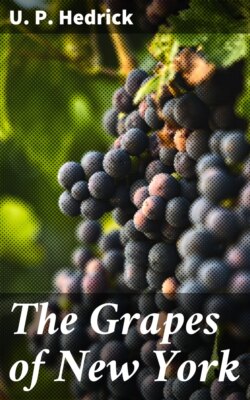Читать книгу The Grapes of New York - U. P. Hedrick - Страница 51
На сайте Литреса книга снята с продажи.
20. VITIS CARIBÆA De Candolle.[149]
ОглавлениеTable of Contents
1. De Candolle, Prodr., 1:634. 1824 (cited by Watson). 2. Chapman, Fl. Sou. States,—:71. (cited by Watson). 3. Buckley, U. S. Pat. Off. Rpt., 1861:483. 4. Engelmann, Bush. Cat., 1883:10, 12, 14, 15. 5. Munson, Am. Hort. Soc. Rpt., 1885:136. Caloosa. 6. (?) Ib., Soc. Prom. Ag. Sci. Rpt., 1887:59. Prof. Curtis’ grape. 7. Planchon, De Candolle’s Mon. Phan., 5:323, 330. 1887. 8. Munson, U. S. D. A. Pom. Bul., 3:14. 1890. 9. Ib., Gar. and For., 3:474. 1890. 10. Ib., Mich. Hort. Soc. Rpt., 1893:116. 11. Bailey, Gray’s Syn. Fl., 1:428. 1897. 12. Viala and Ravaz, Am. Vines, 1903:42, 52.
Vine slender, climbing; shoots more or less woolly, or rarely nearly glabrous; diaphragms medium to thick; tendrils intermittent, rarely continuous, bifid or frequently trifid. Leaves cordate, usually entire when mature, frequently acuminate pointed; teeth shallow, wide, mucronate, slightly rugose above, thick whitish or rusty pubescence below; stipules small. Clusters large, long, with long, slender peduncle. Berries small to very small, purple or black with thin bloom, intensely acid until very ripe. Seeds usually but one or two to the berry, small to very small (Engelmann states that the Florida forms give larger seeds than those from the West Indies), notched; chalaza more or less circular, depressed, usually distinct; raphe a groove or slightly distinct. Very variable.
Caribæa was first described by De Candolle and later by many other botanists but the species is not yet well known owing to its habitat. Caribæa is an inhabitant of the West Indies, middle and southern Florida, Louisiana, eastern Mexico, Yucatan, and various portions of tropical America. It is said to grow largely on lowlands.
The species is of no practical interest as it does not thrive and soon dies in temperate climates. Its horticultural characters are unknown.
